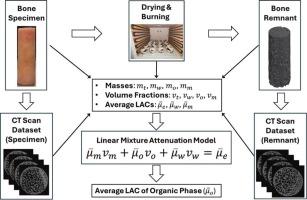Empirical quantification of bone mineral and organic phase attenuation coefficients using CT imaging and controlled thermal processing
IF 3.6
2区 医学
Q2 ENDOCRINOLOGY & METABOLISM
引用次数: 0
Abstract
Accurate quantification of bone mineral, organic, and water phases is critical for evaluating bone quality, assessing fracture risk, and diagnosing skeletal diseases. Dual-energy computed tomography (DECT) holds promise for decomposing these phases but fundamentally relies on precise linear attenuation coefficients (LACs) for each phase. Existing surrogate-based imaging methods—typically assuming fixed phase attenuation coefficients—fail to reflect the compositional heterogeneity of native bone, leading to systematic errors in decomposition. This study presents a novel empirical framework for determining the average LACs of bone mineral and organic phases using 28 standardized cylindrical bovine bone specimens. The method integrates high-resolution CT imaging with a controlled drying–ashing protocol to isolate phase-specific masses and volumes. In conjunction with a linear mixture attenuation model, specimen-wise average LACs for the bone, mineral, and organic phases were characterized at selected energy levels. Results showed the following: 1) Average LACs had wide variability across the specimens, e.g., ranging from 1.16 to 2.38 cm−1 for mineral phase and 0.004–0.085 cm−1 for organic phase at 45 kV, highlighting the limitations of using fixed surrogate-based values. 2) Bone density correlated more strongly with organic density than with mineral density, emphasizing the importance of accurately quantifying the organic phase for bone quality and health assessment. 3) Bone LACs were strongly correlated with mineral LACs but not with organic LACs, underscoring the inability of single-energy CT to capture meaningful information from the organic phase. The proposed empirical framework demonstrates the feasibility of characterizing phase-specific LACs in real bone tissue and may support physiologically accurate DECT modeling, advancing personalized, composition-based bone diagnostics.

骨矿物和有机相衰减系数的经验定量利用CT成像和控制热处理
准确定量骨矿物、有机和水相对于评估骨质量、评估骨折风险和诊断骨骼疾病至关重要。双能计算机断层扫描(DECT)有望分解这些相位,但基本上依赖于每个相位的精确线性衰减系数(LACs)。现有的基于替代物的成像方法——通常假设固定相位衰减系数——无法反映天然骨的成分异质性,导致分解的系统性误差。本研究提出了一个新的经验框架来确定骨矿物和有机相的平均LACs使用28标准化圆柱形牛骨标本。该方法将高分辨率CT成像与受控干燥灰化方案相结合,以分离相特异性质量和体积。结合线性混合衰减模型,在选定的能量水平上表征了骨、矿物和有机相的平均lac。结果表明:1)不同样品的平均LACs具有广泛的差异,例如,在45 kV下,矿物相的平均LACs变化范围为1.16 ~ 2.38 cm−1,有机相的平均LACs变化范围为0.004 ~ 0.085 cm−1,这突出了使用固定的代物值的局限性。2)骨密度与有机相的相关性大于与矿物质相的相关性,强调了准确量化有机相对骨质量和健康评估的重要性。3)骨LACs与矿物LACs密切相关,而与有机LACs无关,这表明单能量CT无法从有机相获取有意义的信息。提出的经验框架证明了在真实骨组织中表征阶段特异性LACs的可行性,并可能支持生理上准确的DECT建模,推进个性化的、基于成分的骨诊断。
本文章由计算机程序翻译,如有差异,请以英文原文为准。
求助全文
约1分钟内获得全文
求助全文
来源期刊

Bone
医学-内分泌学与代谢
CiteScore
8.90
自引率
4.90%
发文量
264
审稿时长
30 days
期刊介绍:
BONE is an interdisciplinary forum for the rapid publication of original articles and reviews on basic, translational, and clinical aspects of bone and mineral metabolism. The Journal also encourages submissions related to interactions of bone with other organ systems, including cartilage, endocrine, muscle, fat, neural, vascular, gastrointestinal, hematopoietic, and immune systems. Particular attention is placed on the application of experimental studies to clinical practice.
 求助内容:
求助内容: 应助结果提醒方式:
应助结果提醒方式:


